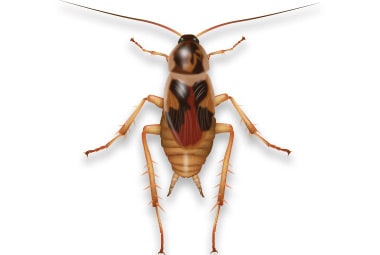
The Brown-Banded cockroach was introduced to Florida in the early 1900s from Africa. Currently, the Brown-Banded cockroach is a common pest found in the northeastern, southern, and Midwest regions of the United States. This cockroach gets its name from the tan and partial bands that cross the wings of the adults near their shoulders on their thorax.
| Pest Identification | |
|---|---|
| Recognition | Adult male brown-banded cockroaches grow to be about 1/2 inch long and are light brown in color, with fully developed wings. The females are shorter and more stout than the males and their wings do not cover the entire abdomen. Female brown-banded cockroaches cannot fly. They are an active species and adult males will fly quickly away when disturbed. The distinctive banding is found on both the nymphs and adults. |
| Biology | Instead of laying individual eggs, the female brown-banded cockroach produces egg capsules (oothecae). Each egg capsule will contain 10 – 18 eggs. During a female cockroach’s average lifetime of 206 days, she will lay about 14 egg capsules. Once the female produces her egg capsule she carries it with her for 24-36 hours. Then she detaches it from herself and re-attaches it in a safe place. Areas like the underside of furniture, on walls, ceilings, cabinets, or behind appliances. The time it takes for the eggs to hatch and the young to mature into adults varies dramatically depending on the environmental conditions. In favorable conditions, it can take as little as 90 days, but in less than favorable conditions it can take up to 276 days. |
| Habits | Unlike many other species of cockroaches, the brown-banded cockroach prefers warm (over 80 degrees) and dry locations. They are more likely to be found in higher elevations within your home and located away from water sources. These heat-seekers are found in many common areas in our homes. Here are some examples of their hiding spots: Cedar shake siding or roofs, in pantries and closets, behind door frames and on thresholds, behind and inside light switch plates, and in attics. One of the best ways to identify this particular cockroach species is by their droppings. They leave a trail of waste behind them as they move about your home. Their feces looks similar to black flecks (pepper) or black smears and can be found on ceiling crown molding, behind picture frames, and along light fixtures. |
| Prevention | The prevention and control of brown-banded roaches can generally be accomplished by making some environmental and sanitation changes around your home and by having a professional pest control plan in place. There are many things that you can do around your home to deter brown-banded cockroaches from moving in. The best way to prevent an infestation is to make sure all screens are intact, caulk any exposed cracks and crevices and make sure that all food is stored in sealed containers or in the refrigerator instead on counters or tables. |
| Professional | If brown-banded cockroaches have infiltrated your home the safest and most effective way to eliminate them is with the help of a professional. Here at Rottler, our technicians use a combination of baits, non-repellent insecticide formulations and pest monitors (sticky traps) to trap and eliminate brownbanded cockroaches from your home. Baits are particularly effective, but correct placement is essential. Incorporating ongoing pest monitoring into the service greatly helps with long-term control. |

